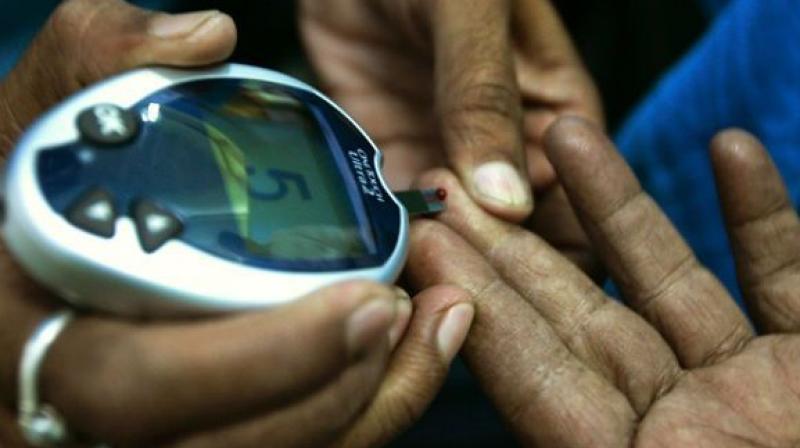Diabetes rising, Hyderabad clocks highest hit at 16.6 per cent
Nutritionist Sujatha Stephen explained, “The diet of South Indians is mostly rice.\"

Hyderabad: Undiagnosed diabetes in India is as high as 9.1 per cent, adding a burden of vascular problems in the population, as per an analysis by the Indian Council of Medical Research. The review found that the highest incidence of diabetes mellitus among the population is in Hyderabad at 16.6 per cent, Thiruvananthapuram at 16.3 per cent, Chennai at 13.5 per cent, New Delhi at 11.6 per cent and Mumbai at 9.3 per cent.
Genetic factors are not the cause of all the diseases. Researchers state that the shift in lifestyle in terms of high calorie foods and low levels of activity is, rather, a prime reason for the increasing cases.
Nutritionist Sujatha Stephen explained, “The diet of South Indians is mostly rice. They eat rice in different forms and that’s one of the major reasons for diabetes in this part of India. People eat a complex of carbohydrates, saturated fats and sugar. The diet lacks in whole grains, millets and low carbohydrates, which will go a long way in controlling abdominal obesity and also the early advent of the disease.”
Dr K.D. Modi, consultant endocrinologist, explained, “Food habits have seen a major change where there is dependence on rice, high and dense calorie foods. A maximum number of those affected are in sitting jobs. In the productive age-group from 35 to 50 years, where we are seeing an increasing number, the lifestyle is to eat, sit, go home and sleep. There is no time for outdoor activity or physical fitness and that is proving to be a causative factor for increasing incidence of diseases in the younger age group.”
Dr Bipin Kumar Sethi, senior endocrinologist, explained, “Central obesity, where the waist-to-hip ratio is higher, is one of the major reasons for diabetes among Indians. This leads to a situation where the protective hormones are secreted less and there are more of fatty acids in circulation. When there is an increased level of fatty acids, this decreases the capacity of the pancreas to produce insulin and control sugars.”
Given this situation, experts state that there are a large number of patients who complain of consistent rise in blood pressure, high blood sugar levels, craving for sugar after meals, fatigue after meals and increase in thirst and appetite. Forty per cent of the patients in hospitals are from higher and middle income groups, and the advent of the disease affects their social and economic life.
Lifestyle change continues to be a big challenge for patients who are not able to cope with the pressure and increasing social and economic challenges at the work front, which is proving to be a major deterrent. Adding to this is a segment of middle and low income groups, where the disease is often not identified.
Dr Sridevi Patnala, senior endocrinologist, explained, “Most patients are not diagnosed properly, or they simply skip the diagnosis due to economic reasons. Hence they come to the hospital with vascular problems. At that stage, considerable damage is done to the vascular system. Hence, identifying them in the periphery areas and also in the far-flung districts with random blood sugar tests is important. Get these people into the fold of institutional care.”
Killer disease
- 17 million people suffered from kidney problems arising out of diabetes.
- 85% of diabetes is almost related to obesity.
- 4% of adults are engaged in some form of physical activity.
- Diabetes is found in those as young as 13.
- Increasing physical activity and following a low carbohydrate, low fat diet daily can prevent or postpone the onset of diabetes.
- One out of every six adolescent in India is now overweight.
- Long-term effects of diabetes Can include blindness, gangrene, renal failure and heart disease.
- 382 million: Was the estimated global prevalence of diabetes in the adult population in 2013, showing a prevalence rate of 8.3%.
- 31.7 million: In India suffer from diabetes.
- 9.1%: Is the rate of undiagnosed diabetes, according to the Chennai urban rural epidemiology study.
- 8.2%: Is the prevalence rate of diabetes in urban areas
- 2.4%: Prevalence in rural areas.
Change your food habits
- Skip sugary drinks and fizz; say no to sweet tea, juice, soda, lemonade and other sugar coated drinks.
- Reduce the size of food portions – Eat six times a day in limited quantities.
- Introduce whole grains and fibre in your foods – eat legumes, millets and whole grains in various combinations which will help to keep the stomach full.
- Choose low-fat foods and dairy foods – opt for low-fat oils, eat more of nuts, seeds and low-fat dairy milk.

